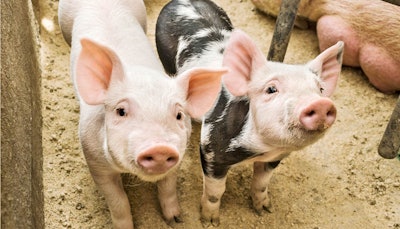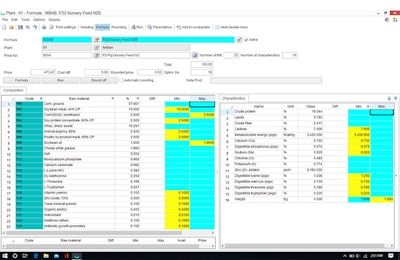How the swine feed formulas were created
Sponsored by Allix3 formulation software
Overview explains the development of the swine segment of the Animal Feed Formulations Library project.

In this second installment of the WATT Feed Formulas Library, we present a complete set of formulas for all major classes of swine. For this, we opted to represent swine feed formulas as expected to be found in a typical U.S. program. Although the number of formulas used in any given farm can vary considerably, this set of 12 formulas reflects practice in the majority of commercial herds. Notable exceptions can be integrated operations or very small farms that are likely to use more or fewer formulas, respectively.
Learn More: Swine Feed Formulations, a downloadable Excel spreadsheet includes 12 swine feed formulation variations for young, grower-finishing and breeding pig diets.
Please read the disclaimer
Before we begin, it is important for everyone to read carefully the disclaimer, which can also be found in its entirety at the end of this document. In brief, these formulas are not complete (finished) as finer details have been left out. The parts missing, such as additives and vitamin/mineral premix specifications, are either covered in other publications or will be published in the future as part of this library of feed formulas. For the moment, their absence does not distract from the informational purpose of the formulas as the basic aspects of nutrition are described in sufficient detail. Nevertheless, these formulas should not be used for any other purpose, commercial or not. As always, it is strongly advised to consult with a local nutrition professional before using any published information.
Ingredient databases
As these formulas refer to typical U.S. feeds, it was considered essential to formulate them using ingredient nutrient values as found in the most recent NRC (U.S., 2012) publication titled “Nutrient Requirements of Swine.” Nevertheless, some ingredients (such as amino acids) or some specific values for other ingredients were not available in the aforementioned publication, and for that purpose, the INRA-AFZ (France, 2004) publication titled “Table of Composition and Nutritional Value of Feed Materials” (and as updated at www.feedtables.com) was used to fill such gaps.
The fact that we have relied on table values can only reinforce the informational purpose of these formulas as any nutritionist attempting to formulate commercial feeds would prefer local actual data, such as those based on laboratory analyses over a long period of time.
Nutrients and values
To formulate these formulas for pigs, we have opted for the metabolizable energy (ME) system, ignoring the more accurate net energy system. This was done because the ME system is used widely in the U.S. and the narrow list of common ingredients we included in our formulas conform perfectly to the capabilities of the ME system.
The same could have been said for the case of total versus digestible amino acids (and phosphorus), but the use of their digestible form is now the norm in the U.S.; and as such these values were used in our formulation. We have not used the digestible calcium values, preferring to remain with total calcium instead, as this is a rather new concept largely untested under commercial conditions.
All other nutrients were included based on their total concentration. Here, it should be noted that, for fiber, we used crude fiber, despite all its shortcomings, because the ingredients listed did not offer much scope in changing to another form of fiber description.

Feed formulation system and least-costing
All feeds were formulated twice on a least-cost basis. First, using the Solver add-on feature of Excel on a spreadsheet designed for the personal use of the author. Second, on A-system’s Allix3, a new commercial feed formulation program to verify the first run on Excel. Happily, the two sets were identical and the Excel version is presented here for ease of use. An example screenshot of the Allix3 formulation system is also presented for educational purposes.
The end formulas were rounded in their ingredient concentration partly to reflect industry practice and partly to make them easier to describe in the accompanying text; some nutritionists prefer to leave this step up to the feed plant or not perform it at all. Some more information in this matter is given under the individual subsets for nursery and growing-finishing pigs.
Dietary specifications for different genetics and sexes
Unlike poultry, pig genetics remain largely fragmented with on-farm cross-breeding still very prevalent, although this is not as common today in most U.S. farms. We have decided to base our specifications on the levels presented in the NRC (2012) publication as this is the latest official recommendation in the U.S. Then, we adjusted certain nutrients to reflect commercial practice were we believed the nutrient requirements were too low to represent dietary specifications, that must always include a certain margin of safety.
For growing pigs, these values represent mixed-sex feeding, assuming that gilts and barrows (or boars) have different requirements that can be met by different intake levels of the same feed. More accurately, separate feeds would be required for each sex, if this is practically possible under commercial conditions, but doing so for this project would offer little in terms of practical information as this relates to basic nutrition principles.
The same can be argued for breeding pigs that can be offered different formulas at different stages, as can be easily reviewed at the NRC (2012) publication. Again, these refinements are beyond the scope of this project, but the interested reader is urged to consult the above publication for much in-depth information.
Additives and premixes
As with the broiler formulas, additives remain a future part of this project. Some additives, nevertheless, were considered absolutely essential for the purpose of this discussion, and they are indicated by broad references, and further discussed in the text. The same is true for the premixes of vitamins and trace minerals, that are absolutely essential, but their composition is again part of a future development. Finally, as for medications, this is the decision of the attending veterinarian, and we have assumed they will be used as needed. These formulas do not represent feeds for an antibiotic-free program.
Download as a spreadsheet
For those who would like the formulas in an Excel format, a working spreadsheet is available for download. Be advised that, although all information (energy and nutrients) used in the creation of these formulas is included and the functionality of the cells recalculating dietary specifications as ingredient concentrations change remain intact, the least-cost formulation ability has been removed. Thus, the formulas will not be able to rebalance automatically to 100% if something is altered unless this is done manually. In other words, the spreadsheets are not the feed formulation program used for the creation of these formulas.
So, please, use them with even more caution and only if you know nutrition, formulation and Excel very well. These downloads are provided without further follow-up service and the same disclaimers and copyrights appeal as the published version — and even extend to any alterations you decide to make, especially in the case of liability.
Have a look at the general information of the poultry formulas. As this is the second part of a greater project, some parts of the designer’s thoughts have been repeated here, whereas others have been omitted. It would be advisable to have a look at least at the general information section of the poultry formulas to get a broader perspective about the whole project and visualize its progress.
Table of Contents
In 2020, WATT Global Media and Ioannis Mavromichalis, Ph.D. published a series of animal feed formulas as a general information resource material. These formulas are not complete, but the exclusions, such as additives and vitamin/mineral premix specifications, are either covered in other publications or will be published in the future as part of this library of feed formulas.
Layer feed formulations and analysis
The article acts as a guide to describe Mavromichalis’ approach to the development of the series and frames how to use the information found throughout.
General: How layer feed formulas for U.S. white and EU red layers were created
Each installment of the layer feed formula installment includes analysis and sample formulations for typical layer diets for both U.S. white and EU red hens during both the development and production phases of the life cycle. In total, there are 12 formulas.
- Feed formulations for white US layers in the development phase
- Feed formulations for US white layers in the production phase
- Feed formulations for EU red layers in the development phase
- Feed formulations for EU red layers in the production phase
Swine feed formulations and analysis
This article acts as a guide to describe Mavromichalis’ approach to the development of the series and frames how to use the information found throughout.
General information: How the swine feed formulations were created
Each swine feed formulation feature includes analysis of the defined diet and includes sample formulations for different points in a pig’s life cycle: nursery/young pigs, grower-finishing and breeding.
- Piglet feed formulations
- Common US grower-finishing pig feed formulations with corn, soybeans and DDGS
- Breeding pig feed formulation commonly used in US diets
Broiler feed formulations and analysis
This article acts as a guide to describe Mavromichalis’ approach to the development of the series and frames how to use the information found throughout.
General information: How the broiler feed formulas were created
Each separate broiler feed formulation feature includes analysis of the defined diet and includes sample formulations of rations at different points in the life cycle of the broiler chicken: starter, grower and finisher.
- Traditional US broiler feed formulations with corn, soybean meal and poultry meal with antibiotics
- All-vegetable US broiler feed formulations with corn and soybean meal without antibiotics
- Modern European broiler feed formulations with wheat, soybean meal, rapeseed meal & fish meal without antibiotics
DISCLAIMER: All information under the section of Animal Feed Formulations Library is provided only as an information resource. It is not to be used or relied upon for any academic, commercial, public, private or other purposes. This information is not intended to be education for students or any other professional and does not create a student-mentor relationship. This information is not intended to be consulting for private or public entities and persons and does not create a client-consultant relationship. This information should not be used as a substitute for professional advice. Please consult with your local nutritionist, extension professional, feed representative or specialist, veterinarian or animal science technician before making any nutrition related decisions or for guidance about any specific nutritional or other issue.
Ioannis Mavromichalis, Ph.D., WATT Global Media and their owners, affiliates and employees shall have no liability for any damages, loss, injury, financial or animal performance and results, or liability whatsoever suffered as a result of your reliance provided in this section, even after your consulting with your advisers.
Contacts:
For comments, questions or suggestions, please contact Ioannis Mavromichalis, [email protected], or Feed Strategy's editor Jackie Roembke, [email protected].